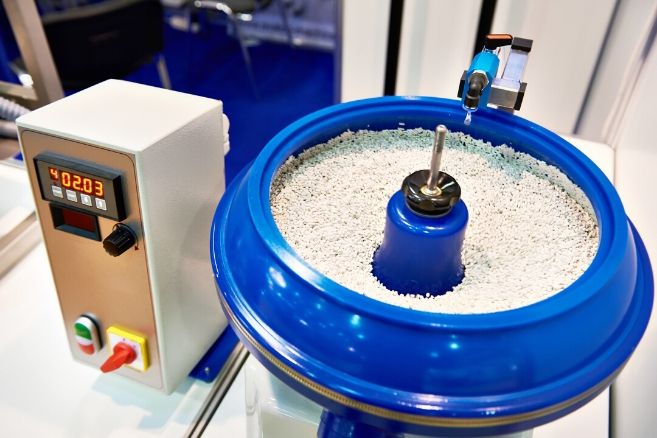Differences Between Tumble Finishing and Vibratory Finishing
Posted by Bill Wright on

Metal and machine shops need machines and processes that deburr, remove rust, and scale and polish metal parts. The process can improve the function and appearance of the parts by removing imperfections that occur during the manufacturing from cutting, stamping, or heating. This process prepares parts for coating, if necessary. These machines and processes can “finish” batches of parts in a short amount of time.
Deburring and polishing machines typically use some kind of media. Made of plastic, ceramic, or porcelain, it combines with a specially formulated liquid. From here, vibration and rotation cause the media to rub against metal parts. The friction that results removes imperfections, rust or scales, and/or polishes the metal. The two main types of machines are vibrating machines or barrel tumbling machines. There are important differences between tumble finishing versus vibratory finishing to consider. The primary difference between barrel tumbling and vibratory systems is how they generate friction to remove imperfections from metal.
Barrel Tumbling
With the barrel tumbling process, the metal parts go into a barrel with abrasive media, finishing compounds, and water; the barrel rotates, causing the parts and media to tumble inside the barrel, similar to rocks rolling down a hill. The tumbling action creates friction between media and the metal parts, deburring them. The barrel grinds with a higher applied force than a vibratory system.
Vibratory Finishing
With barrel tumblers, the deburring or cutting action happens only in the slide area of the barrel—about 25% of the load. With vibratory finishing equipment, the materials go into a bowl or tub, and the entire load shakes all at once. This can cause the parts and media to rotate or move up and down within the tub, sort of like cake batter in a mixing bowl. However, the parts and media rub against each other much more than if they tumbled against the surface of the tub. The cutting action, or friction, in a vibratory system, occurs with every pulse of vibration. Vibratory systems finish parts with action that is more like filing, and they do it more quickly, producing a smoother finish. With the vibratory finishing process, you can also cut inside a metal part, reaching every area the selected media can get into. Vibratory systems lend themselves better to automation and they are better for big or delicate parts. However, vibratory deburring machines are more expensive and more complicated than barrel systems, but they produce finer results with less wear on the parts.
Overall, barrel tumbling is a coarser process that produces rounded-off corners, but uneven surfaces. It’s more suitable for foundry castings and parts with heavy radii. Barrel systems are best for tougher materials and hard metal pieces that need heavier action to remove imperfections.
Vibratory systems work for large and small parts and create a smoother finish. Determining which method and machine are right for your job involves thinking about the type of metal you’re finishing, the toughness or delicacy of the parts you’re deburring, and whether the look and smoothness of the finished part is a top concern. At AccuBrass, we’ll answer your questions about the difference between tumble finishing versus vibratory finishing machines. Our team can help you determine what kind of machine and media will work for you.
Share this post
0 comment


